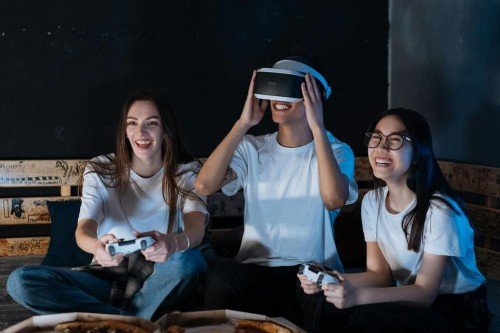
In 2025, gaming is no longer just a pastime, it’s a culture, a communication medium, and for many, a shared language that transcends borders. From Tokyo to Toronto, millions of people are connecting daily through online worlds, forming friendships, collaborating on missions, and expressing themselves through avatars and virtual identities. What once separated people, geography, language, and culture, now unites them through play.
Gaming as the Universal Connector
The rise of gaming has created a new kind of literacy. Players from entirely different backgrounds can jump into a game and instantly understand what to do, explore, build, compete, or cooperate. Words become secondary when action, intuition, and strategy drive communication. A gamer from Brazil can team up with another from Poland, coordinate a mission wordlessly, and still feel a sense of shared understanding.
This universal “language” of gaming doesn’t rely on grammar or vocabulary, it’s built on shared rules, goals, and emotions. A well-timed assist, a victory dance, or an in-game emote can communicate more than words ever could. Developers have learned to design experiences that appeal to this emotional universality, making gameplay intuitive and symbolically rich.
From Play to Global Communities
Games are now the world’s largest social platforms. In 2025, the global gaming population has surpassed 3.5 billion players. That’s nearly half of humanity participating in interactive experiences that blend entertainment, learning, and social connection. Platforms like Fortnite, Roblox, and Genshin Impact are not just games, they’re social ecosystems where players hang out, attend virtual concerts, and even celebrate real-life milestones.
These digital communities demonstrate how games break down linguistic and cultural barriers. Players create their own hybrid dialects of emojis, slang, and gameplay gestures that feel natural across cultures. It’s a powerful reminder that the desire to connect is universal, and gaming provides the perfect space for it.
Education, Empathy, and Digital Identity
Beyond fun, games have become tools for learning and empathy. Educational institutions are integrating game mechanics into virtual classrooms to make learning more interactive. Students collaborate in simulation games to solve real-world problems, from climate policy to urban planning. This gamified approach doesn’t just teach content, it teaches collaboration, creative problem-solving, and adaptability, the same skills that define global citizenship.
Games also help people explore identity and empathy in ways traditional media cannot. Through role-playing, players can experience perspectives vastly different from their own, stepping into another gender, nationality, or moral dilemma. Titles like Life Is Strange or Detroit: Become Human show how gaming can foster emotional literacy, encouraging players to think deeply about choice, consequence, and compassion.
The Economic Power of Play
The gaming industry in 2025 is one of the most powerful economic forces on the planet, valued at over $250 billion. It surpasses the combined revenue of music and film. Beyond entertainment, gaming now drives innovations in software development, artificial intelligence, and virtual communication tools.
Interestingly, the same technologies that make global gaming possible, cloud computing, real-time translation, and low-latency voice channels, are transforming other sectors too. Companies providing remote interpretation services have adopted similar infrastructure to facilitate multilingual communication in healthcare, law, and business. The cross-pollination between gaming and professional communication tools highlights how entertainment continues to inspire enterprise solutions.
Cross-Cultural Collaboration in Real Time
Modern multiplayer games depend on seamless, real-time interaction. As players form global teams, they must coordinate across languages and time zones. Developers are responding with integrated voice recognition, live captioning, and AI-powered translation features that make communication effortless.
It’s not just about talking, it’s about understanding cultural nuance. Games increasingly localize not only language but humor, gestures, and visual cues. For instance, a quest designed for players in Japan may include subtle cultural references that differ from the European version. This sensitivity to context mirrors how remote interpretation services ensure that meaning, not just words, is accurately conveyed. The result is a more inclusive, culturally intelligent gaming landscape that welcomes everyone, regardless of background or linguistic ability.
Games as Cultural Bridges
In an era of polarization, gaming communities often serve as neutral ground. Inside a game, nationality matters less than teamwork and shared passion. Players who might disagree politically or socially in real life can still find common ground in a cooperative mission or creative world-building project.
Esports exemplify this bridge-building power. International tournaments bring together teams from dozens of countries, watched by millions online. Fans don’t need to share a spoken language to cheer for a brilliant strategy or celebrate a flawless victory. The emotional resonance of competition is universal, the same thrill that fuels sports, storytelling, and art.
The Future of Human Connection
As virtual reality, augmented reality, and AI-driven game design evolve, the boundaries between the physical and digital will continue to blur. Games are becoming extensions of our social and emotional lives. They teach us how to collaborate, communicate, and empathize across divides that once felt insurmountable.
The “global language” of gaming will only grow richer as technology advances. Future generations will not only play games but use them as spaces to learn, innovate, and express identity. In a world fragmented by politics and geography, play may be our most natural path to unity. Because at its heart, gaming is not about machines or code, it’s about people. About finding joy, purpose, and understanding in shared experiences. And in that sense, games are not just entertainment, they are the universal conversation of the digital age.
Le plus lu
Articles en vedette

L’Impact Caché du Jeu Vidéo sur la Société Moderne






